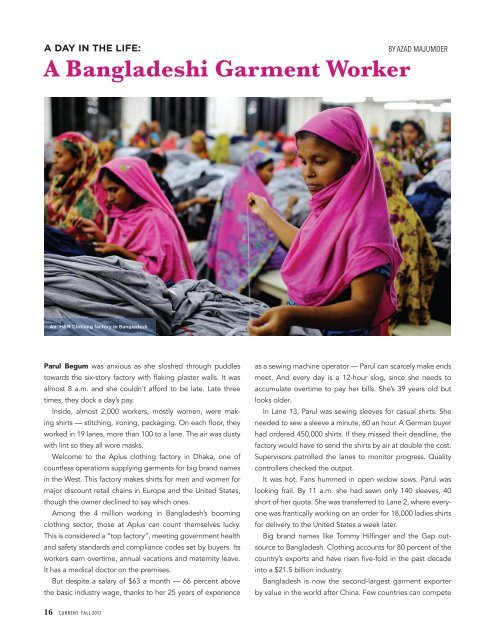Current Magazine
Create successful ePaper yourself
Turn your PDF publications into a flip-book with our unique Google optimized e-Paper software.
A DAY IN THE LIFE:<br />
BY AZAD MAJUMDER<br />
A Bangladeshi Garment Worker<br />
An H&M Clothing factory in Bangladesh.<br />
Parul Begum was anxious as she sloshed through puddles<br />
towards the six-story factory with flaking plaster walls. It was<br />
almost 8 a.m. and she couldn’t afford to be late. Late three<br />
times, they dock a day’s pay.<br />
Inside, almost 2,000 workers, mostly women, were making<br />
shirts — stitching, ironing, packaging. On each floor, they<br />
worked in 19 lanes, more than 100 to a lane. The air was dusty<br />
with lint so they all wore masks.<br />
Welcome to the Aplus clothing factory in Dhaka, one of<br />
countless operations supplying garments for big brand names<br />
in the West. This factory makes shirts for men and women for<br />
major discount retail chains in Europe and the United States,<br />
though the owner declined to say which ones.<br />
Among the 4 million working in Bangladesh’s booming<br />
clothing sector, those at Aplus can count themselves lucky.<br />
This is considered a “top factory”, meeting government health<br />
and safety standards and compliance codes set by buyers. Its<br />
workers earn overtime, annual vacations and maternity leave.<br />
It has a medical doctor on the premises.<br />
But despite a salary of $63 a month — 66 percent above<br />
the basic industry wage, thanks to her 25 years of experience<br />
as a sewing machine operator — Parul can scarcely make ends<br />
meet. And every day is a 12-hour slog, since she needs to<br />
accumulate overtime to pay her bills. She’s 39 years old but<br />
looks older.<br />
In Lane 13, Parul was sewing sleeves for casual shirts. She<br />
needed to sew a sleeve a minute, 60 an hour. A German buyer<br />
had ordered 450,000 shirts. If they missed their deadline, the<br />
factory would have to send the shirts by air at double the cost.<br />
Supervisors patrolled the lanes to monitor progress. Quality<br />
controllers checked the output.<br />
It was hot. Fans hummed in open widow sows. Parul was<br />
looking frail. By 11 a.m. she had sewn only 140 sleeves, 40<br />
short of her quota. She was transferred to Lane 2, where everyone<br />
was frantically working on an order for 18,000 ladies shirts<br />
for delivery to the United States a week later.<br />
Big brand names like Tommy Hilfinger and the Gap outsource<br />
to Bangladesh. Clothing accounts for 80 percent of the<br />
country’s exports and have risen five-fold in the past decade<br />
into a $21.5 billion industry.<br />
Bangladesh is now the second-largest garment exporter<br />
by value in the world after China. Few countries can compete<br />
16 CURRENT FALL 2017





